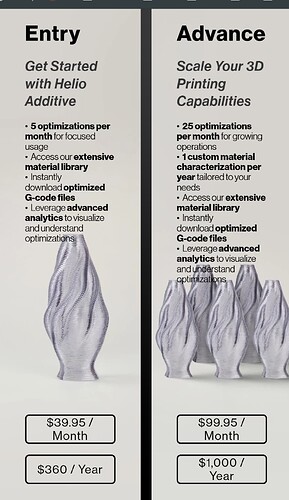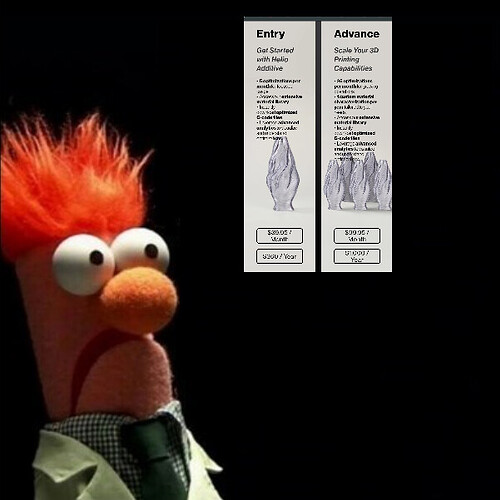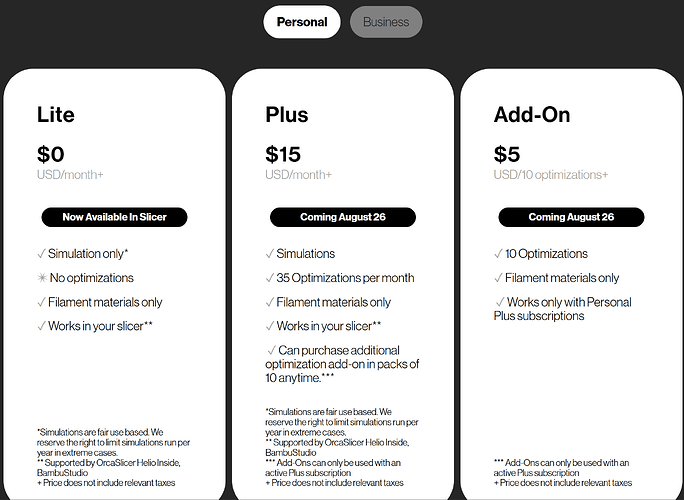BL has anounced software update to V2.2.0.
One of the highlights is a thermal simulation tool comming from a company called Helio Additive. Looking deeper into it, it seems this is not to be a free service, but willl be cherged.
Is this assumption correct? Perhaps an official statement from BL could clarify this matter.
I’m trying to figure this out now. I just downloaded the beta version with Helio. Reading Helio’s privacy policy they state they “sell or share your personal information with third parties” for business and commercial purposes.
If you print proprietary designs, prototypes, or personal items: You should be aware that the details of these models will be sent to Helio Additive and their partners. Given that your data may be sold, you should carefully consider if the benefit of the feature outweighs the potential privacy risk.
If their gcode damages your printer in any way they are not liable. Any dispute resolution has to happen in Hong Kong.
I really wanted to check this out but I don’t think it’s worth letting them sell all of my data including the g-code and they hold no responsibility if they damage your printer.
Be interested to see how this actually performs. It sounds like the “optimization” process makes changes to extruder temperature as a function of layer height and position within a layer, depending on what kind of feature is being extruded. The nozzle temp doesn’t change all that quickly. Particularly when heating up. Does the print speed have to slow down so the nozzle temperature has time to change on a region by region basis?
I can’t be precise, but from the tests and reading I did a couple of days ago:
- The software runs a thermal simulation of the printing process, assesses the deviation from the ideal solution, i.e. higher or lower temperature than the ideal process, and optimises the G-code to overcome those deviations;
- I couldn’t find how the simulations are carried out, besides their claim “It uses first-principles physics to simulate how temperature evolves throughout a print.”.
- It uses the sliced print info (G-code). Hence, it considers the geometry, material, and settings; additionally, it requires the input of the ambient, or chamber temperature, which you need to estimate unless using the X1E or H2D, or have modded the printer.
- EDIT: It only works with a few filaments, most from Polymaker, Fiberon and BL, but not all e.g. BL filaments with fibres, multicolour and multi-material prints are not currently supported. According to the information, there are no limitations regarding filaments with fibres or if crystalline or amorphous, but it’s required to send the materials for characterisation, likely a service.
- I was to make a test with ABS and PC, as the results were indeed surprisingly bad, with PC showing too low a temperature in all layers, but for the current version, it only shows the simulation results, and doesn’t optimise the g-code, so I couldn’t verify if it works. EDIT: This limitation is within the slicer, as it is possible to use their web tool for optimisation.
- I got further info from their wiki and docs webpage. One interesting test result with X1E and PC: 65% Stronger Prints with Dragon: Optimizing PC on Bambu Lab X1E | Helio Additive Wiki
and also enjoyed the fact of having an API: API |, which could be helpful; - I notice their privacy statement, but soon discard it as I realised that I may do some tests, but I’m certain the tool isn’t for me because of their pricing:
When I think about $ 40$ per month, and get five optimisations, it adds $ 8$ to a print. It could be worth it in precise prints, and with filaments they still do not support, but not as a subscription. Maybe BL will come up with a discount subscription…
Edit: After reading and testing the web tool, I found I was wrong regarding the materials and usage limitation; I identified the edited text in bold.
$8 to optimize relatively easy to print filaments… that does not sound like a good deal. Plus they harvest and promise to re sell all the data you supply. They should be paying users who are naive enough/ want to use their „optimalisation”
Is this meant for a company that cranks out the same part over and over so they would just have to optimize it once?
Yes, this software appears to be targeted at commercial users of 3D printers. I doubt it’ll be more than another source of frustration for non-commercial users.
If you go to their website, they have a picture of the sliced model, optimized model, and the actual print. The actual print looks like ■■■■, to put it bluntly. Not a strong endorsement of what their product does. The “results” image should look perfect and not like they ran with a filament on a printer that hadn’t been tuned.
But why would you they do that? The pictures they show should show off the results of the software. One model printed with defaults, one model printed with their tuning. But no. So I went looking for some actual data or before/after to back up their claims of stronger prints, but there’s nothing for that either.
Sorry, BBL, this looks more like snake oil than a real product that does something positive.
Does it get rid of the benchy hull line?
It wouldn’t be living up to its hype if it couldn’t. ![]()
A couple of news stories in my feeds this morning.
Don’t know why this link didn’t embed correctly…
Seems the pricing has changed:
So simulations in the Slicer seem to be free, as soon as you want optimizations (not available yet in Bambu Studio) you would need to pay.
Those prices look fair if you really can have benefit from them.
I don’t see any negative with this introduction. In all honesty, I have wanted to see this since last year when AON3D introduced theirs.
This is from the Helio Wiki:
Bambu Studio Integration with Helio Simulation
Simulate thermal behavior directly inside Bambu Studio using Helio Additive’s physics-based engine — for stronger, more reliable prints.
Preview layer-by-layer thermal performance
Catch weak bonding or overheating before you print
Works with X1C, X1E, and H2D printers + supported Bambu filaments
No hardware changes. No new slicer. Just smarter simulation built in.
I specifically like the 2nd point, find thermally created weak points sliced in to the files.
Its also a separate action after slicing so I’d imagine it will not slow down slicing models where you don’t need the simulation.
The only weird part from their Wiki, is this. (Does it mean that it will not be free to simulate after the Beta, or that only 5000 keys will be allowed at any one time). If it is a straight limit, might be a good idea to grab the Beta key and hope it ports over to the main slicer branch.
Free Access During Beta
- 5000 free PAT keys available globally
- First come, first served
- Claim a key to activate simulation
- Additional batches may be released based on demand
Is the simulation happening client side without internet? Or is this happening on the cloud? If cloud, remember that you’re directly giving away all your design files to yet another chinese company…
Its very slow, so I’m assuming cloud based, but it could just be calculations being run client side. I haven’t tried disabling network access and running it.
I assumed it was only available in the Beta Studio, but it looks like the new version of Studio was released and its on it so download the update, enable Helio in the preferences, and give it a shot. Basically, green is ideal temps and blue and red means its too cold or too hot for good bonding (too cold) and good esthetics (too hot). I’m trying to figure out what value it has for determining warping ahead of time.
You can bring up Task Manager and watch the process to see how hard it’s working the CPU/Disk/Network, should be pretty clear which resource is being consumed heaviest.
The thing about the optimizations is that it’s implied nozzle temperature will be continuously variable, they insert stuff in to the G-Code to affect these changes so different regions of the model can be printed at different temperatures. But the nozzle temperature doesn’t change instantaneously, there’s a “time constant” that is going to be measured in seconds at best, >10s at worst. I still haven’t seen anything about how these changes are implemented so that they don’t radically slow print time.
Almost anything gets better if you print it slower. I don’t need their software for that. ![]()
I am almost 100% sure this is running server side. In the progress, you see that data is uploaded and at 35% the progress is paused and waiting while server is calculating the result.
There is a clause about fair use. If it would be running client side, the fair use policy has no real use.
Yeah. If it was processing locally, someone could buy the software and reverse engineer how it does what it does, and then copy it. If the processing is in the cloud, their IP is much better protected.
just got a key and i’m trying it , and the quality looks remarkably better.
Zen
Pictures or it didn’t happen. ![]()
Give us a before/after showing how much the print quality improved. If you can, with focus on areas on the “before” that printed poorly but looked better on the “after”.
you don’t order me around dude…


